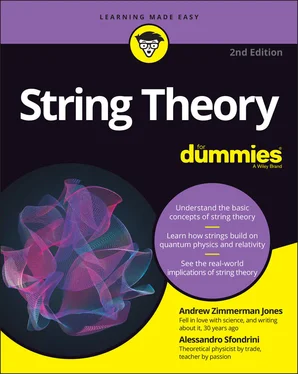Lay out the avenues of study that are attempting to gain more evidence for string theory.
Explore the bizarre (and speculative) implications of string theory.
Present the critical viewpoints in opposition to string theory, as well as some alternatives that may bear fruit if string theory proves to be false.
Have some fun along the way.
Avoid mathematics at all costs. (You’re welcome!)
We hope you, good reader, find that we’ve been successful at meeting these goals.
And while time may flow in only one direction (Or does it? We explore this in Chapter 17), your reading of this book may not. String theory is a complex scientific topic that includes a lot of interconnected concepts, so jumping between concepts isn’t quite as easy as it may be in some other For Dummies reference books. We’ve tried to help you out by including quick reminders and providing cross-references to other chapters where necessary. So feel free to wander the pages to your heart’s content, knowing that if you get lost, you can work your way back to the information you need.
About the only assumption we’ve made in writing this book is that you’re reading it because you want to know something about string theory. We’ve even tried not to assume that you enjoy reading physics books. (We do, but we try not to project our own strangeness onto others.)
We have assumed that you have a passing acquaintance with basic physics concepts — maybe you took a physics class in high school or have watched some of the scientific programs about gravity, light waves, black holes, or other physics-related topics on cable channels or your local PBS station. You don’t need a degree in physics to follow the explanations in this book, although without a degree in physics you may be amazed that anyone can make sense of any theory so disconnected from our everyday experience. (Even with a physics degree, it can boggle the mind.)
As is customary in string theory books for the general public, the mathematics has been avoided. You need a graduate degree in mathematics or physics to follow the mathematical equations at the heart of string theory, and we’ve assumed that you don’t have either one. Don’t worry — while a complete understanding of string theory is rooted firmly in the advanced mathematical concepts of geometry and quantum field theory, we’ve used a combination of text and figures to explain the fascinating ideas behind string theory.
Throughout the book, you’ll find icons in the margins that are designed to help you navigate the text. Here’s what these icons mean:
 Although everything in this book is important, some information is more important than other information. This icon points out information that will definitely be useful later in the book.
Although everything in this book is important, some information is more important than other information. This icon points out information that will definitely be useful later in the book.
 In science, theories are often explained with analogies, thought experiments, or other helpful examples that present complex mathematical concepts in a way that is more intuitively understandable. This icon indicates that one of these examples or hints is being offered.
In science, theories are often explained with analogies, thought experiments, or other helpful examples that present complex mathematical concepts in a way that is more intuitively understandable. This icon indicates that one of these examples or hints is being offered.
 Sometimes we go into detail that you don’t need to know to follow the basic discussion and that’s a bit more technical (or mathematical) than you may be interested in. This icon points out that information, which you can skip without losing the thread of the discussion.
Sometimes we go into detail that you don’t need to know to follow the basic discussion and that’s a bit more technical (or mathematical) than you may be interested in. This icon points out that information, which you can skip without losing the thread of the discussion.
In addition to what you're reading right now, this book also comes with a free access-anywhere Cheat Sheet. To get it, simply go to www.dummies.com and look for String Theory for Dummies Cheat Sheet in the Search box.
If you want to learn more about some of the ideas that laid the basis or string theory, you can also check out Einstein for Dummies by Carlos I. Calle.
The For Dummies books are organized in such a way that you can surf through any of the chapters and find useful information without having to start at Chapter 1. We (naturally) encourage you to read the whole book, but this structure makes it very easy to start with the topics that interest you the most.
If you have no idea what string theory is, then we recommend looking at Chapter 1as a starting point, then moving through Chapters 2- 3for a basic overview of what we’re talking about. Chapter 4focuses on laying some foundational ideas about how theoretical science advances. If your physics is rusty, pay close attention to Chapters 5– 9, which cover the history and current status of the major physics concepts that pop up over and over again.
If you’re familiar with string theory but want some more details, jump straight to Chapters 10and 11, where we explain how string theory came about and reached its current status. Chapters 12and 13go a bit deeper into the specifics, including the recent insights from the holographic principle. Chapter 14offers some ways of testing the theory, while Chapters 15– 17take concepts from string theory and apply them to some fascinating topics in theoretical physics.
Some of you, however, may want to figure out what all the recent fuss is with people arguing across the blogosphere about string theory. For that, we recommend jumping straight to Chapter 18, which addresses some of the major criticisms of string theory. Chapters 19and 20focus heavily on other theories that may either help expand or replace string theory, so they’re a good place to go from there.
Part 1
Introducing String Theory
IN THIS PART …
Understand the basics of string theory.
Grasp the fundamentals of quantum gravity.
Explore the accomplishments and failures of string theory.
Chapter 1
So What Is String Theory Anyway?
IN THIS CHAPTER
 Knowing that string theory is based on vibrating strings of energy
Knowing that string theory is based on vibrating strings of energy
 Understanding the key elements of string theory
Understanding the key elements of string theory
 Hoping to explain the entire universe with string theory
Hoping to explain the entire universe with string theory
 Studying string theory could be the driving scientific goal of the 21st century
Studying string theory could be the driving scientific goal of the 21st century
String theory is a work in progress, so trying to pin down exactly what string theory is, or what its fundamental elements are, can be kind of tricky. Regardless, that’s exactly what we try to do in this chapter.
In this chapter, you gain a basic understanding of string theory. We outline the key elements of string theory, which provide the foundation for most of this book. We also discuss the possibility that string theory is the starting point for a “theory of everything,” which would define all of our universe’s physical laws in one simple (or not so simple) mathematical formula. Finally, we look at the reasons why you should care about string theory.
Читать дальше

 Although everything in this book is important, some information is more important than other information. This icon points out information that will definitely be useful later in the book.
Although everything in this book is important, some information is more important than other information. This icon points out information that will definitely be useful later in the book. In science, theories are often explained with analogies, thought experiments, or other helpful examples that present complex mathematical concepts in a way that is more intuitively understandable. This icon indicates that one of these examples or hints is being offered.
In science, theories are often explained with analogies, thought experiments, or other helpful examples that present complex mathematical concepts in a way that is more intuitively understandable. This icon indicates that one of these examples or hints is being offered. Sometimes we go into detail that you don’t need to know to follow the basic discussion and that’s a bit more technical (or mathematical) than you may be interested in. This icon points out that information, which you can skip without losing the thread of the discussion.
Sometimes we go into detail that you don’t need to know to follow the basic discussion and that’s a bit more technical (or mathematical) than you may be interested in. This icon points out that information, which you can skip without losing the thread of the discussion. Knowing that string theory is based on vibrating strings of energy
Knowing that string theory is based on vibrating strings of energy










